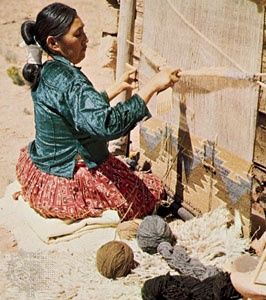Navajo weaving
art
 blankets and rugs made by the Navajo and thought to be some of the most colourful and best-made textiles produced by North American Indians. The Navajo, formerly a seminomadic tribe, settled in the southwestern United States in the 10th and 11th centuries and were well established by 1500. With a new life as a sedentary and agricultural people, the tribe began to practice weaving, which had been virtually unknown to them, learning from the Hopi how to build looms and construct fabrics on a large scale. The introduction of domestic sheep by Europeans revolutionized weaving by making a steady supply of wool available, and the Navajo began to raise sheep for wool.
blankets and rugs made by the Navajo and thought to be some of the most colourful and best-made textiles produced by North American Indians. The Navajo, formerly a seminomadic tribe, settled in the southwestern United States in the 10th and 11th centuries and were well established by 1500. With a new life as a sedentary and agricultural people, the tribe began to practice weaving, which had been virtually unknown to them, learning from the Hopi how to build looms and construct fabrics on a large scale. The introduction of domestic sheep by Europeans revolutionized weaving by making a steady supply of wool available, and the Navajo began to raise sheep for wool.The Hopi had limited their designs to striped patterns, but the Navajo introduced geometric shapes, diamonds, lozenges, and zig-zags. Symbolic representations of such phenomena as the elements, the seasons, and the times of day did not develop until about 1820. Mexican design influenced Navajo weaving.
Before 1800, Navajo blankets were largely made of natural-coloured wool—black, white, and a mixture of the two that produced gray; a limited amount of dyeing was done, with roots, herbs, and minerals from the rich soil of the area, primarily producing dark colours, like those of the Hopi. Shortly after the turn of the 19th century, however, red bayeta cloth purchased from the Spaniards was unraveled and the thread used to make Navajo textiles. The introduction of aniline dyes in the late 19th century led to a period in Navajo weaving characterized by bright and even gaudy designs. Vividly coloured yarns were used to weave into the rugs and blankets a broad range of decorative motifs based on commonplace modern objects; representations of automobiles, bottles, tomato cans, and airplanes, for example, found their way into the formerly dignified and restrained fabrics.
More traditional, geometric designs subsequently regained their popularity and are once again the dominant patterns. Weaving remains a vital aspect of contemporary Navajo community life and of its economy.
- Sir Granville Bantock
- Sir Halford John Mackinder
- Sir Hall Caine
- Sir Hamilton Harty
- Sir Hamo Thornycroft
- Sir Hans Adolf Krebs
- Sir Hans, Baronet Sloane
- Sir Hans Sloane, Baronet
- Sir Harold Jeffreys
- Sir Harold Nicolson
- Sir Harold Spencer Jones
- Sir Harold W. Kroto
- Sir Harry Atkinson
- Sir Harry, Baronet Smith
- Sir Harry Hamilton Johnston
- Sir Harry Lauder
- Sir Harry Smith, Baronet
- Sir Hector Macdonald
- Sir Henry Alfred Lytton
- Sir Henry Barkly
- Sir Henry, Baronet Royce
- Sir Henry Bessemer
- Sir Henry Bradwardine Jackson
- Sir Henry Campbell-Bannerman
- Sir Henry Christopher Mance